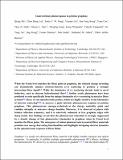Giant intrinsic photoresponse in pristine graphene
Author(s)
Ma, Qiong; Lui, Chun Hung; Song, Justin C. W.; Lin, Yuxuan; Kong, Jian Feng; Cao, Yuan; Dinh, Thao H.; Nair, Nityan L.; Fang, Wenjing; Watanabe, Kenji; Taniguchi, Takashi; Xu, Su-Yang; Kong, Jing; Palacios, Tomas; Gedik, Nuh; Gabor, Nathaniel M.; Jarillo-Herrero, Pablo; ... Show more Show less
Download1812.07111.pdf (1.700Mb)
Terms of use
Metadata
Show full item recordAbstract
When the Fermi level is aligned with the Dirac point of graphene, reduced charge screening greatly enhances electron–electron scattering 1–5 . In an optically excited system, the kinematics of electron–electron scattering in Dirac fermions is predicted to give rise to novel optoelectronic phenomena 6–11 . In this paper, we report on the observation of an intrinsic photocurrent in graphene, which occurs in a different parameter regime from all the previously observed photothermoelectric or photovoltaic photocurrents in graphene 12–20 : the photocurrent emerges exclusively at the charge neutrality point, requiring no finite doping. Unlike other photocurrent types that are enhanced near p–n or contact junctions, the photocurrent observed in our work arises near the edges/corners. By systematic data analyses, we show that the phenomenon stems from the unique electron–electron scattering kinematics in charge-neutral graphene. Our results not only highlight the intriguing electron dynamics in the optoelectronic response of Dirac fermions, but also offer a new scheme for photodetection and energy harvesting applications based on intrinsic, charge-neutral Dirac fermions.
Date issued
2018-12Department
Massachusetts Institute of Technology. Department of Physics; Massachusetts Institute of Technology. Department of Electrical Engineering and Computer Science; Massachusetts Institute of Technology. Research Laboratory of ElectronicsJournal
Nature Nanotechnology
Publisher
Nature Publishing Group
Citation
Ma, Qiong et al. “Giant Intrinsic Photoresponse in Pristine Graphene.” Nature Nanotechnology 14, 2 (December 2018): 145–150 © The Author(s)
Version: Author's final manuscript
ISSN
1748-3387
1748-3395